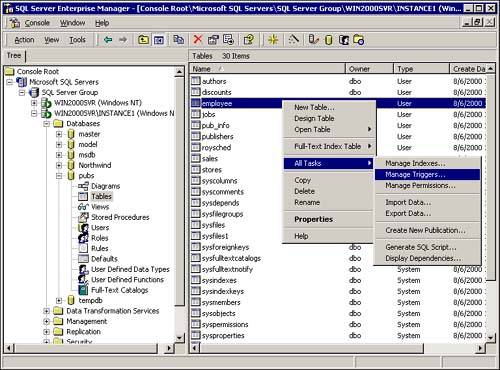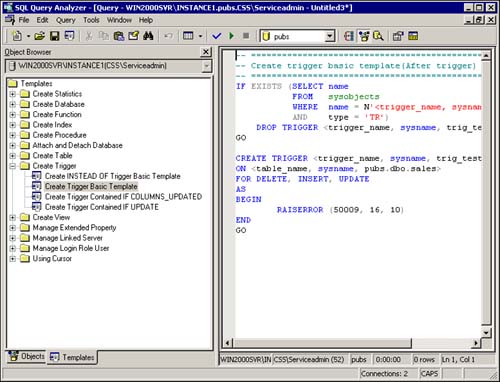Creating Triggers
| You can create and manage triggers in SQL Enterprise Manager. Right-click the table for which you want to manage triggers and choose All Tasks, Manage Triggers from the pop-up menu (see Figure 29.1). Figure 29.1. Managing triggers for the current table in SQL Enterprise Manager. Figure 29.2 displays the Trigger Properties window that is displayed after you select a table for which you want to manage a trigger. It provides a basic template from which you can code your trigger. Figure 29.2. The Trigger Properties window.
Another alternative for managing triggers is Query Analyzer. With SQL Server 2000, a couple of new tools have been added to the Query Analyzer to facilitate the creation or modification of triggers. The first addition is the Object Browser that allows you to manage database objects, including triggers. Figure 29.3 shows the Edit menu option for triggers in the Object Browser. It also shows the resulting trigger text (shown in the background) that was generated after the Edit option was chosen for an existing trigger on the employee table in the Pubs database. Figure 29.3. Managing triggers with the Query Analyzer Object Browser. The other new Query Analyzer feature for managing triggers is a template. Templates are the basic building blocks for commonly added database objects. SQL Server 2000 added this new feature to streamline the creation of common database objects, including triggers. Figure 29.4 displays the Template tab of Query Analyzer and the available templates for trigger creation. The template text for the creation of a basic trigger is displayed in the right pane of Query Analyzer. Figure 29.4. Query Analyzer Trigger Templates. The template variables , such as <trigger name >, can be changed manually or replaced using the Replace Template Parameters option available on the Edit menu of Query Analyzer. After you have your basic trigger template, you can code the trigger with limited restrictions. Almost every Transact-SQL statement that you would use in a SQL batch or stored procedure is also available for use in the trigger code. The commands that cannot be used in a trigger are found in the following list:
|
EAN: 2147483647
Pages: 503
- Chapter VI Web Site Quality and Usability in E-Commerce
- Chapter VIII Personalization Systems and Their Deployment as Web Site Interface Design Decisions
- Chapter XII Web Design and E-Commerce
- Chapter XV Customer Trust in Online Commerce
- Chapter XVIII Web Systems Design, Litigation, and Online Consumer Behavior



